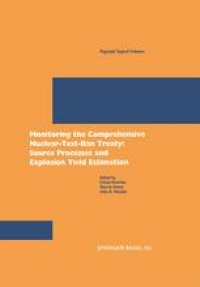
Ebook: Monitoring the Comprehensive Nuclear-Test-Ban Treaty: Source Processes and Explosion Yield Estimation
Author: Göran Ekström Marvin Denny John R. Murphy (auth.) Göran Ekström Marvin Denny John R. Murphy (eds.)
- Tags: Geophysics/Geodesy
- Series: Pageoph Topical Volumes
- Year: 2001
- Publisher: Birkhäuser Basel
- Edition: 1
- Language: English
- pdf
Pure appl. geophys., by 161 nations. Entry of the treaty into force, however, is still uncertain since it requires ratification by all 44 nations that have some nuclear capability and, as of 15 June 2001, only 31 of those nations have done so. Although entry of the CTBT into force is still uncertain, seismologists and scientists in related fields, such as radionuclides, have proceeded with new research on issues relevant to monitoring compliance with it. Results of much of that research may be used by the International Monitoring System, headquartered in Vienna, and by several national centers and individual institutions, to monitor compliance with the CTBT. New issues associated with CTBT monitoring in the 21st century have presented scientists with many new challenges. They must be able to effectively monitor com pliance by several countries that have not previously been nuclear powers. Effective monitoring requires that we be able to detect and locate much smaller nuclear events than ever before and to distinguish them from small earthquakes and other types of explosions. We must have those capabilities in regions that are seismically active and geologically complex, and where seismic waves might not propagate efficiently.
This volume presents summaries of recent research results on the related subjects of source processes and explosion yield estimation, which are important elements of any treaty verification system. The term Source Processes, in the context of nuclear test monitoring, refers to a wide range of research topics. In a narrow definition, it describes the complex physical phenomena that are directly associated with a nuclear explosion, and the catastrophic deformation and transformation of the material surrounding the explosion. In a broader sense, it includes a host of topics related to the inference of explosion phenomena from seismic and other signals. A further widening of the definition includes the study and characterization of source processes of events other than nuclear, such as earthquakes and, in particular, mining explosions. This latter research is especially important relative to the question of identifying and discriminating nuclear explosions from other seismic events. Explosion Yield Estimation deals with the corresponding inverse problem of inferring explosion source characteristics through analyses of the various types of seismic signals produced by the explosion. This is a complex technical task which has been the focus of some of the most contentious treaty monitoring debates. The current compilation of eight articles on Source Processes and six articles on Explosion Yield Estimation gives a good representation of state-of-the-art research currently being conducted in the broad area of seismic source characterization in the context of nuclear test monitoring.